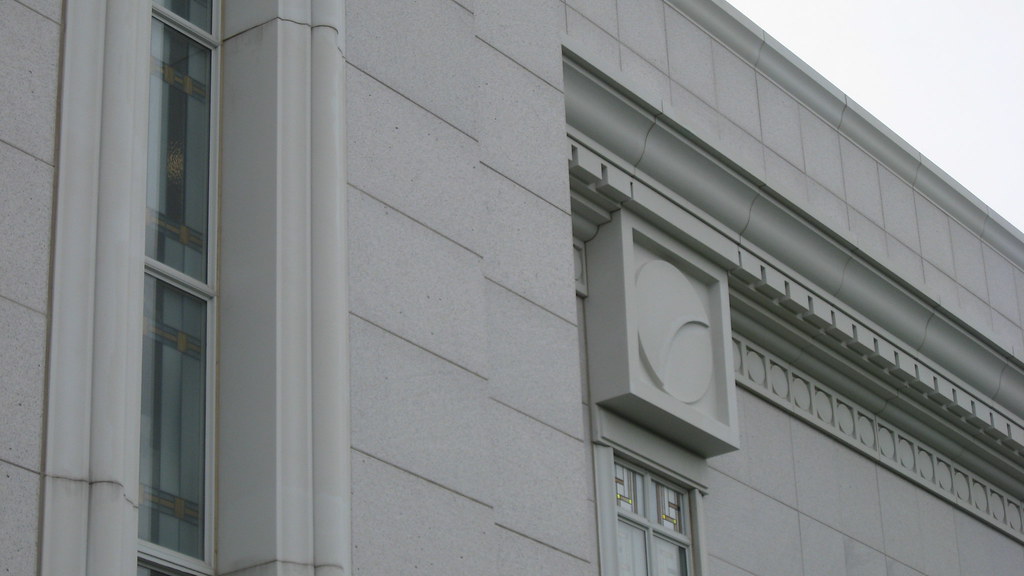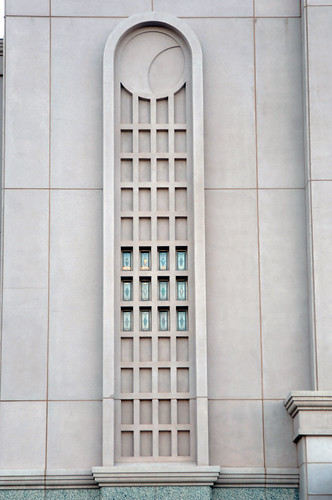Earlier I wrote a post on Latter-day Saint temple sunstones. Now I want to discuss a related symbol - moonstones.
Symbolic moonstones are used on many temples built by The Church of Jesus Christ of Latter-day Saints and first appeared on the Nauvoo Illinois Temple. These were crescent moons and you may notice that the stones include the silhouette of a face. If you read my sunstone post, you will remember that the sunstone face had apparently been shown to Joseph Smith in a vision and represented some actual person. I don't know if the same is true for the moonstone, but it too has a face. Also in my sunstone post I discussed that the sun, moon, and star stones in this and many other temples primarily represent the vision of John in Revelations 12:1. The moonstones are also located just above the ground level (or in later temples above the earth stones) and can thereby represent things above the earth, or greater than just this earth. I once read in Sunstone magazine that the Nauvoo Temple moonstones represented feminism and the divine feminine. I don't buy that argument. I'm not going to go more into this, but I think it is a horribly wrong interpretation of this symbol. Women have a valued, equal place in the church, but the moonstones aren't on the Nauvoo Temple to teach late 20th and early 21st century feminism.
 |
| Nauvoo Temple Moonstone |
 |
| Salt Lake Temple Moonstones (see original photo) |
The Salt Lake Temple was the next to use moonstones. These moonstones are now round and are more realistic representations of the moon. The moons go through various phases, carved as the moon appeared on various days in the year 1878. An observatory on temple square was used to get these phases drawn correctly. The New Era says this about the Salt Lake Temple moonstones:
The moon stones, above the promenade, close under the second string course on each buttress, and directly above the earth stones, represent the moon in all its phases. Elder Angell’s architectural drawing of the moon stones describes them as “Buttress Blocks Commencing with Course M2 Representing the Moon in all its Phases. During the year 1878. 13 New Moons. 13 First Quarters. 12 Full Moons. 12 Last Quarters.” The moon stone representing the first quarter of the moon in January 1878 is located midway along the north wall of the temple, with the other phases of the moon being represented in a clockwise pattern around the temple, thereby locating the moon in its phases for the month of April on the central east tower. The moon stones are sometimes thought to represent the terrestrial kingdom.
You can see that time is being represented by the moonstones as they go through the months of a year. It is also interesting to note that April (on the east towers) is significant for the reorganization of the church, which occurred after the Melchizedek priesthood was restored. The east side is also the front of the temple and if the temple represents the church, the month of its organization was a fitting date for the front of the temple. The moonstones going through cycles can also symbolize one eternal round. There may also be symbolism in the dates corresponding to the west towers as the September moonstones are on the west side of the temple and the Angel Moroni first appeared to Joseph Smith on September 21, 1823 in preparation for the restoration of the church and for The Book of Mormon to be given to Joseph Smith. Moonstones also represent time increasing to eternity as the earthstones originally would have gone through days of a month, moonstones through months in a year, and the sunstones represent the sun going through seasons and years. Finally, the big dipper symbol points to the north star, which is unchanging. Thus, the moonstones represent progression towards infinite and eternal things.
 |
| Washington D.C. Temple Moon (original) |
The Washington D.C. Temple was the next temple with moonstones, or rather bronze moon medallions on the doors. These are at the top of the doors opposite the sun medallions. The moon has a crescent reminiscent of the Nauvoo Temple while being a circle like the stones on the Salt Lake Temple. I like the moon as a symbol of the Terrestrial Kingdom of God, the second highest heaven. It also can represent this world in a Terrestrial state as it must be before it becomes the Celestial Kingdom. I mentioned earlier that I don't buy that moonstones are meant to represent the feminine. The Washington D.C. Temple uses the moonstones alongside the sunstones (at the same level of each door). Because of this, if you interpret moonstones to relate to feminine divine nature or something like that, on this temple the symbol would at least imply equality among the sexes. I repeat, I do not think the moonstones are meant to represent the feminine, divine or otherwise.
The Portland Oregon Temple and Las Vegas Nevada Temple both use moonstones arranged like those on the Salt Lake Temple. These go through phases and have the same general meaning as the stones on the Salt Lake Temple. On the Portland Temple the moonstones are made of thinly cut stone that acts as translucent stone windows. During the day, the stones glow on the interior of the temple, and at night they glow on the exterior from the interior light.
The Las Vegas Nevada Temple Moonstones are slightly different, but appear on the temple in the same basic place. They are not translucent in this version.
The Bountiful Utah Temple and Mount Timpanogos Utah Temple each contain moonstones. These are meant to match those on the Salt Lake Temple. As you can see, they are at the tops of windows (the sunstones are at the base of the spire). I like the use of this symbol, although I don't find these moonstones as aesthetically pleasing as those on other temples.
The St. Louis Missouri Temple has a large art glass window with many moons, but a discussion of this will have to wait until I post on sun/moon/star stained glass. Several other temples have used similar art glass.
 |
| Portland Oregon Temple Moonstone |
 |
| Las Vegas Temple Moonstone |
 |
| Bountiful Utah Temple Moonstone (original photo) |
The St. Louis Missouri Temple has a large art glass window with many moons, but a discussion of this will have to wait until I post on sun/moon/star stained glass. Several other temples have used similar art glass.
| Preston England Temple Moonstones |
The Preston England Temple uses moonstones in a unique way. The 12 moonstones are oriented with six on the north side and six on the south side. The stones are all at the same level and are combined with the two star stones and two sun stones. The moon stone closest to the front door of the temple on each side is a new moon and forms the center of a star stone. Moving westward (towards the celestial room) there are four moonstones waxing towards a full moon. Then, the moonstone closest to the celestial room on each side is a full moon and forms the center of the sunstones. The Preston moonstones can be read in many ways and may represent:
The three heavens or degrees of glory with the moon as the Terrestrial Kingdom of God
Progression towards the Celestial kingdom as the moon waxes from new to full.
An eternal round, as the moon will wax and wane through its phases if you follow the pattern as you walk around the temple. This can continue endlessly, so it is a symbol for time and eternity.
If the sun stone is seen as representing Jesus Christ or God, the source of light, then the moonstones can symbolize us and that as we approach them we increase in light as the moon increases in light in its phases. Similarly, as we increase in the temple, we increase in light and knowledge
The use of twelve moonstones can also have symbolic meaning.The Preston England Temple is the only temple I've seen with the moonstones displayed in this way. I love it and would like to see similar displays on other temples.
The Bogota Columbia Temple also includes moonstones seen here. This temple shares many architectural characteristics from the Bountiful and Mount Timpanogos Temples.
 |
| Albuquerque N.M. Temple Moonstone |
 |
| Palmyra New York Temple Moonstones |
Although I wasn't going to mention moons in glass, you can see how they are used in the Winter Quarters Nebraska Temple here.
The Columbia River Washington Temple includes many circles that I think are meant to represent moonstones, although these don't have phases on them. The main indication that they are moonstones is the presence of a sunstones on the spire.
Those are the temples that I have identified with moonstones. Several others have moons in the stained glass. To recap (and in some cases explain for the first time), moonstones can represent:
The Terrestrial Kingdom
A Terrestrial or Zion society as we prepare for the future Celestial Kingdom
A Terrestrial or Zion society as we prepare for the future Celestial Kingdom
Time extending towards eternity
Progression
Light
The creation (God created the sun, moon and stars as recounted in the scriptures and temple)
John's vision in Revelation 12:1
Heavenly things
One eternal round
April as the month the church was organized
Degrees of glory
Please comment and let us know what you think about moonstones, symbolism not discussed, architectural use of these stones and how well they are used on each temple or how aesthetically pleasing each use it, or anything else you want to discuss. If you know of any that I've missed, you can also mention that.
I love the rich symbolism that moonstones impart to temple architecture and hope I've helped you see how deep their meanings can run.
Degrees of glory
Please comment and let us know what you think about moonstones, symbolism not discussed, architectural use of these stones and how well they are used on each temple or how aesthetically pleasing each use it, or anything else you want to discuss. If you know of any that I've missed, you can also mention that.
I love the rich symbolism that moonstones impart to temple architecture and hope I've helped you see how deep their meanings can run.
3 comments:
Very nice post! I enjoy your blog. Now, if the "Earth-stones" represent the telestial world,(the world we now live and as depicted in the temple)and the MOON-STONES represent terrestrial kingdom, and the Sun-stones represent the celestial Kingdom...3 kingdoms?? What than do we make of the 182 Saturn-Stones that stand above all three? There is 132 more Saturn-stones than Sun-stones which represents the celestial kingdom? Plus, you have cloud-stones, all seeing eye, big-dipper, many stars including the Star of David, and many, many other symbols which all point to the planet Saturn. Or how bout the goddess Aphrodite which stands above the veil in the salt lake city temple? Saints are uncomfortable with these topics because we have ignored the teachings of the prophet of the restoration. There is an incredible, faith building, mind blowing explanation that fits perfectly with the restored gospel. I recommend looking into plasma cosmology, and the works of Anthony Larson.
I like your discussion of the temple stone symbolism. The stars in the soffit above the main stars that are the most visible are called the "soffit stars'.
You're spot on . From my research .. christ is the moon
Post a Comment